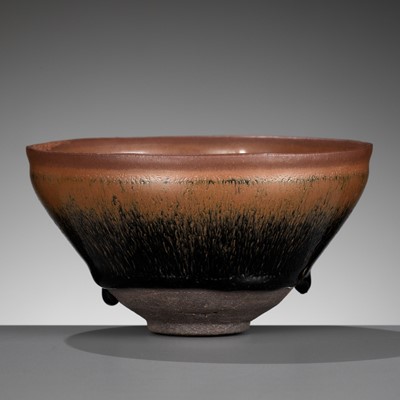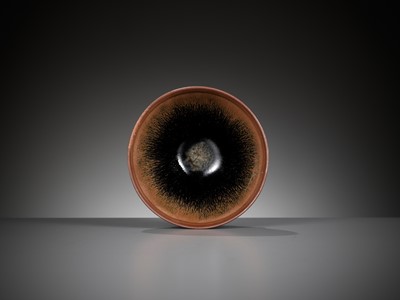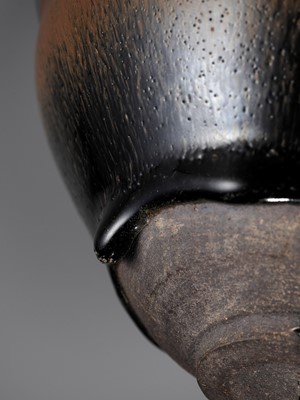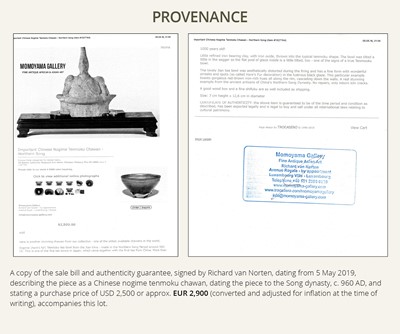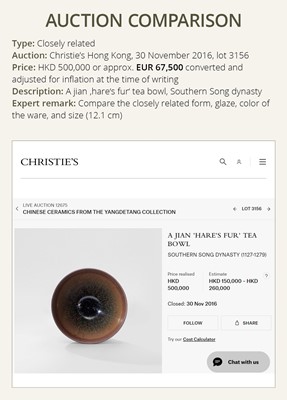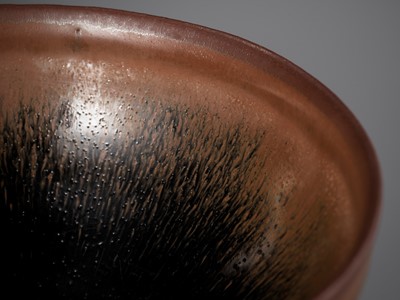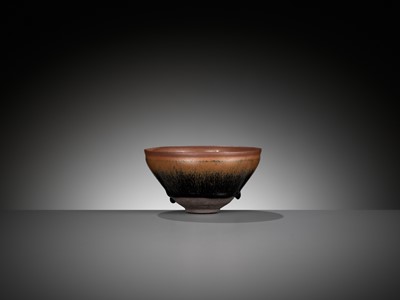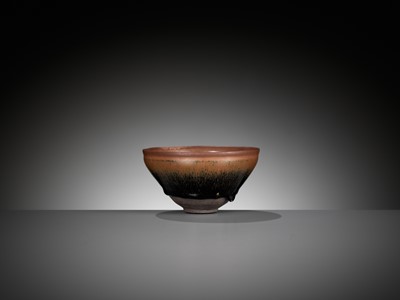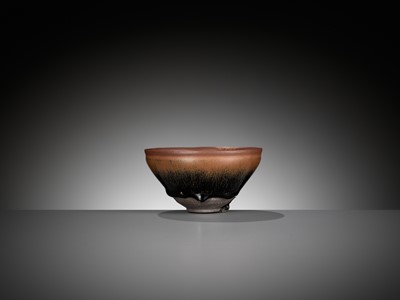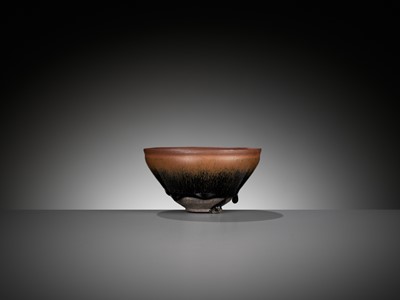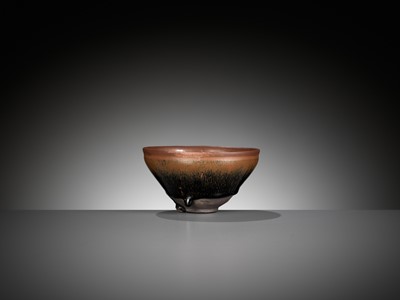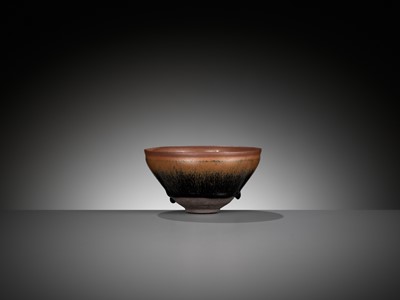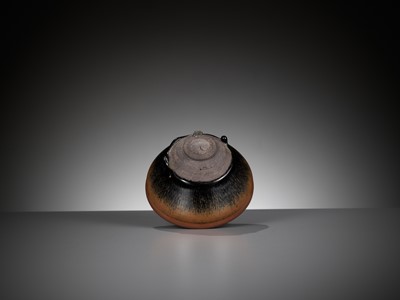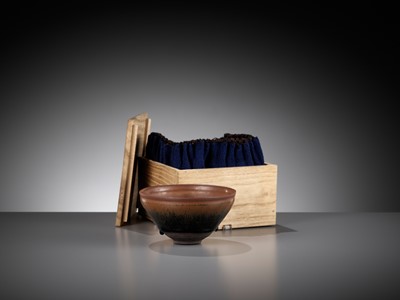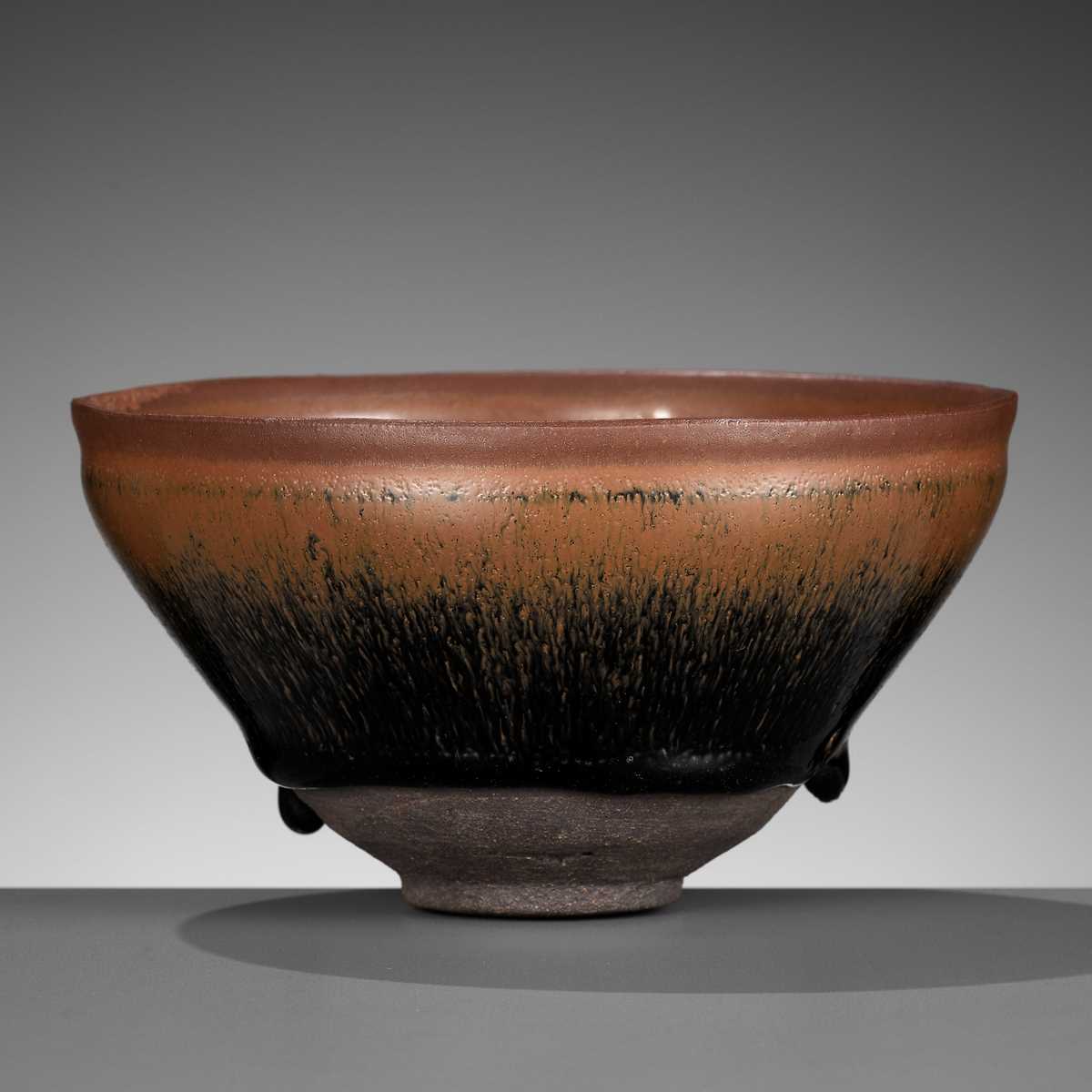10th Mar, 2023 10:00
TWO-DAY AUCTION - Fine Chinese Art / 中國藝術集珍 / Buddhism & Hinduism
368
A JIAN ‘HARE’S FUR’ TEA BOWL, SOUTHERN SONG DYNASTY
南宋建窯兔毫盞
Sold for €1,820
including Buyer's Premium
China, 1127-1279. Thickly potted, of deep conical form, the gently rounded sides rising from a short foot to an indented groove beneath the rim, the interior and exterior covered with a thick black lustrous glaze, with a brown glaze at the rim extending to 'hare's-fur' striations to the sides, the glaze stopping irregularly above the foot forming three large drops and revealing the dark grayish-brown stoneware body underneath.
Provenance: Momoyama Gallery, Luxembourg. A private collection in the United States, acquired from the above. A copy of the sale bill and authenticity guarantee, signed by Richard van Norten, dating from 5 May 2019, describing the piece as a Chinese nogime tenmoku chawan, dating the piece to the Song dynasty, c. 960 AD, and stating a purchase price of USD 2,500 or approx. EUR 2,900 (converted and adjusted for inflation at the time of writing), accompany this lot.
Condition: Very good condition with minor wear, minuscule losses, and manufacturing flaws including firing cracks, firing flaws, glaze recesses, a glaze drop near the foot smoothened with minor associated losses. The wood base with minor old wear and expected age cracks.
Weight: 277.7 g
Dimensions: Diameter 12.5 cm
With a kiri wood storage box and a good shifuku silk pouch. (4)
This classic Jian ware tea bowl has finely streaked ‘hare’s fur’ markings with an iridescent sheen. This effect depends upon various factors such as the kiln atmosphere, and kiln temperature. Due to the uncertainty in firing, the wastage rate at Jian kilns was relatively high.
These bowls were held in high esteem by the Song Emperors and scholar-official class. Cai Xiang (1012-1067), the famous calligrapher and high official in the Northern Song court designated the ‘hare’s fur’ tea bowls from Jian’an the most appropriate utensil for serving tea in his two-chapter treatise entitled Cha lu (A Record of Tea). He believed the white tea looked best in black-glazed bowls and the slightly thicker walls of Jian wares help to retain the heat of tea. By the early twelfth century, the connoisseurship of Jian tea bowls was further developed by Emperor Huizong (1082-1135). In his treatise on tea, Daguan chalun (A Discourse on Tea in the Daguan Era), he commented that ‘the desirable color of a tea bowl is bluish black and the best examples display clearly streaked hairs.’
Auction result comparison:
Type: Closely related
Auction: Christie’s Hong Kong, 30 November 2016, lot 3156
Price: HKD 500,000 or approx. EUR 67,500 converted and adjusted for inflation at the time of writing
Description: A jian 'hare's fur' tea bowl, Southern Song dynasty
Expert remark: Compare the closely related form, glaze, color of the ware, and size (12.1 cm)
南宋建窯兔毫盞
中國,1127-1279年。侈口,深腹壁,小圈足,器內口沿下有一道淺凹槽。胎骨厚重,施罩黑釉,釉色濃稠烏黑,帶有流動性,器外壁施釉不及底,釉層上薄下厚,口沿呈現赭褐色“褐口邊”,外底邊有積釉流淌的垂釉痕跡,釉表帶黃色條縷絲紋,類似野兔毫毛。
來源:盧森堡Momoyama Gallery藝廊;美國私人收藏購於上述藝廊。隨附發票和正品證書複印本,Richard van Norten簽名,時間為2019年5月5日,斷代為宋代,售價USD 2,500 或相當於EUR 2,900 (根據通貨膨脹率)。
品相:品相極佳,輕微磨損,小缺損,製造缺陷包括燒製裂紋、釉面凹陷,足部附近的釉滴有相應的修補、已平滑。木底有輕微的磨損和年代裂縫。
重量:277.7 克
尺寸:直徑12.5 厘米
日本木盒,稱絲質内襯。 (4)
經典建窯茶碗上兔毫紋,散發著彩虹般的光澤。這種效果取決於很多因素,例如窯爐溫度。由於燒製的不確定性,建窯的廢品率較高。
宋代文人之間盛行點茶、鬥茶的活動,為襯托熱水點茶的白色茶沫,以及便於分辨水痕,厚胎保溫的建窯黑釉盞遂成為當時流行的品類,也是茶詩中經常提及的茶器。北宋著名書法家、朝廷大臣蔡襄(1012-1067)在他的兩章《茶錄》一文中,將建安的兔毫盞定為最合適的茶具。他認為白茶放在黑釉碗裡最好看,而建陶稍厚的壁有助於保持茶的熱度。 到十二世紀初,徽宗皇帝(1082-1135)進一步推廣茶道。在他的茶論《大觀茶論》也曾認為茶碗的理想顏色是青黑色。
拍賣結果比較:
形制:非常相近
拍賣:香港佳士得,2016年11月30日,lot 3156
價格:HKD 500,000(相當於今日EUR 67,500)
描述:南宋建窯兔毫盞
專家評論:比較非常相近的外形、釉面、陶色和尺寸 (12.1 厘米)。
China, 1127-1279. Thickly potted, of deep conical form, the gently rounded sides rising from a short foot to an indented groove beneath the rim, the interior and exterior covered with a thick black lustrous glaze, with a brown glaze at the rim extending to 'hare's-fur' striations to the sides, the glaze stopping irregularly above the foot forming three large drops and revealing the dark grayish-brown stoneware body underneath.
Provenance: Momoyama Gallery, Luxembourg. A private collection in the United States, acquired from the above. A copy of the sale bill and authenticity guarantee, signed by Richard van Norten, dating from 5 May 2019, describing the piece as a Chinese nogime tenmoku chawan, dating the piece to the Song dynasty, c. 960 AD, and stating a purchase price of USD 2,500 or approx. EUR 2,900 (converted and adjusted for inflation at the time of writing), accompany this lot.
Condition: Very good condition with minor wear, minuscule losses, and manufacturing flaws including firing cracks, firing flaws, glaze recesses, a glaze drop near the foot smoothened with minor associated losses. The wood base with minor old wear and expected age cracks.
Weight: 277.7 g
Dimensions: Diameter 12.5 cm
With a kiri wood storage box and a good shifuku silk pouch. (4)
This classic Jian ware tea bowl has finely streaked ‘hare’s fur’ markings with an iridescent sheen. This effect depends upon various factors such as the kiln atmosphere, and kiln temperature. Due to the uncertainty in firing, the wastage rate at Jian kilns was relatively high.
These bowls were held in high esteem by the Song Emperors and scholar-official class. Cai Xiang (1012-1067), the famous calligrapher and high official in the Northern Song court designated the ‘hare’s fur’ tea bowls from Jian’an the most appropriate utensil for serving tea in his two-chapter treatise entitled Cha lu (A Record of Tea). He believed the white tea looked best in black-glazed bowls and the slightly thicker walls of Jian wares help to retain the heat of tea. By the early twelfth century, the connoisseurship of Jian tea bowls was further developed by Emperor Huizong (1082-1135). In his treatise on tea, Daguan chalun (A Discourse on Tea in the Daguan Era), he commented that ‘the desirable color of a tea bowl is bluish black and the best examples display clearly streaked hairs.’
Auction result comparison:
Type: Closely related
Auction: Christie’s Hong Kong, 30 November 2016, lot 3156
Price: HKD 500,000 or approx. EUR 67,500 converted and adjusted for inflation at the time of writing
Description: A jian 'hare's fur' tea bowl, Southern Song dynasty
Expert remark: Compare the closely related form, glaze, color of the ware, and size (12.1 cm)
南宋建窯兔毫盞
中國,1127-1279年。侈口,深腹壁,小圈足,器內口沿下有一道淺凹槽。胎骨厚重,施罩黑釉,釉色濃稠烏黑,帶有流動性,器外壁施釉不及底,釉層上薄下厚,口沿呈現赭褐色“褐口邊”,外底邊有積釉流淌的垂釉痕跡,釉表帶黃色條縷絲紋,類似野兔毫毛。
來源:盧森堡Momoyama Gallery藝廊;美國私人收藏購於上述藝廊。隨附發票和正品證書複印本,Richard van Norten簽名,時間為2019年5月5日,斷代為宋代,售價USD 2,500 或相當於EUR 2,900 (根據通貨膨脹率)。
品相:品相極佳,輕微磨損,小缺損,製造缺陷包括燒製裂紋、釉面凹陷,足部附近的釉滴有相應的修補、已平滑。木底有輕微的磨損和年代裂縫。
重量:277.7 克
尺寸:直徑12.5 厘米
日本木盒,稱絲質内襯。 (4)
經典建窯茶碗上兔毫紋,散發著彩虹般的光澤。這種效果取決於很多因素,例如窯爐溫度。由於燒製的不確定性,建窯的廢品率較高。
宋代文人之間盛行點茶、鬥茶的活動,為襯托熱水點茶的白色茶沫,以及便於分辨水痕,厚胎保溫的建窯黑釉盞遂成為當時流行的品類,也是茶詩中經常提及的茶器。北宋著名書法家、朝廷大臣蔡襄(1012-1067)在他的兩章《茶錄》一文中,將建安的兔毫盞定為最合適的茶具。他認為白茶放在黑釉碗裡最好看,而建陶稍厚的壁有助於保持茶的熱度。 到十二世紀初,徽宗皇帝(1082-1135)進一步推廣茶道。在他的茶論《大觀茶論》也曾認為茶碗的理想顏色是青黑色。
拍賣結果比較:
形制:非常相近
拍賣:香港佳士得,2016年11月30日,lot 3156
價格:HKD 500,000(相當於今日EUR 67,500)
描述:南宋建窯兔毫盞
專家評論:比較非常相近的外形、釉面、陶色和尺寸 (12.1 厘米)。
Zacke Live Online Bidding
Our online bidding platform makes it easier than ever to bid in our auctions! When you bid through our website, you can take advantage of our premium buyer's terms without incurring any additional online bidding surcharges.
To bid live online, you'll need to create an online account. Once your account is created and your identity is verified, you can register to bid in an auction up to 12 hours before the auction begins.
Intended Spend and Bid Limits
When you register to bid in an online auction, you will need to share your intended maximum spending budget for the auction. We will then review your intended spend and set a bid limit for you. Once you have pre-registered for a live online auction, you can see your intended spend and bid limit by going to 'Account Settings' and clicking on 'Live Bidding Registrations'.
Your bid limit will be the maximum amount you can bid during the auction. Your bid limit is for the hammer price and is not affected by the buyer’s premium and VAT. For example, if you have a bid limit of €1,000 and place two winning bids for €300 and €200, then you will only be able to bid €500 for the rest of the auction. If you try to place a bid that is higher than €500, you will not be able to do so.
Online Absentee and Telephone Bids
You can now leave absentee and telephone bids on our website!
Absentee Bidding
Once you've created an account and your identity is verified, you can leave your absentee bid directly on the lot page. We will contact you when your bids have been confirmed.
Telephone Bidding
Once you've created an account and your identity is verified, you can leave telephone bids online. We will contact you when your bids have been confirmed.
Classic Absentee and Telephone Bidding Form
You can still submit absentee and telephone bids by email or fax if you prefer. Simply fill out the Absentee Bidding/Telephone bidding form and return it to us by email at office@zacke.at or by fax at +43 (1) 532 04 52 20. You can download the PDF from our Upcoming Auctions page.
How-To Guides
How to Create Your Personal Zacke Account
How to Register to Bid on Zacke Live
How to Leave Absentee Bids Online
How to Leave Telephone Bids Online
中文版本的操作指南
创建新账号
注册Zacke Live在线直播竞拍(免平台费)
缺席投标和电话投标
Third-Party Bidding
We partner with best-in-class third-party partners to make it easy for you to bid online in the channel of your choice. Please note that if you bid with one of our third-party online partners, then there will be a live bidding surcharge on top of your final purchase price. You can find all of our fees here. Here's a full list of our third-party partners:
- 51 Bid Live
- EpaiLive
- ArtFoxLive
- Invaluable
- LiveAuctioneers
- the-saleroom
- lot-tissimo
- Drouot
Please note that we place different auctions on different platforms. For example, in general, we only place Chinese art auctions on 51 Bid Live.
Bidding in Person
You must register to bid in person and will be assigned a paddle at the auction. Please contact us at office@zacke.at or +43 (1) 532 04 52 for the latest local health and safety guidelines.
